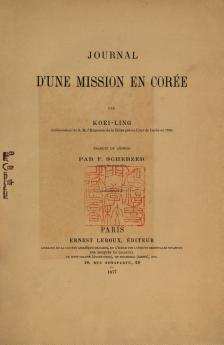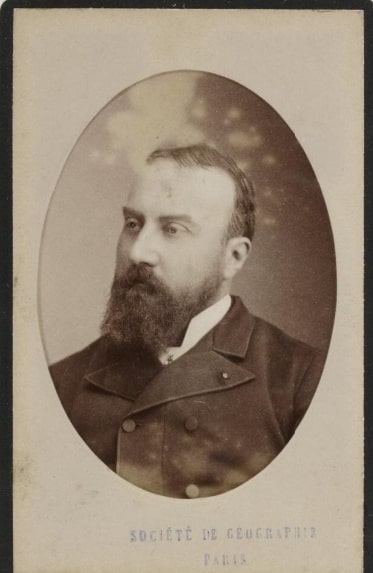
Journal d'une Mission en Corée
Par Kouei Ling
Ambassadeur de S. M. L’Empereur de la Chine près la Cour de Corée en 1866
Traduit du Chinois par F. Scherzer
Journal of a Mission in Korea
By Kouei Ling
Ambassador of His Majesty the Emperor of China to the Korean Court in 1866
Translated from the Chinese by F. Scherzer
Paris: Ernest Leroux
1877
東使紀事詩略
瓜爾佳魁齡 Guaerjia Kuiling (1815-1878)
The author was sent as imperial
ambassador to Seoul in 1866 to bring the Emperor's
permission for the marriage of the young king Gojong.
This is the day-by-day journal of his journey and the
ceremonies during his short stay in Seoul.
An
online scan of the original French text.
A corrected OCR of the French text (PDF)
An English translation of the French text (PDF)
(Covering pages 1-39,
pages 41-62 are the translator’s notes, not translated)
The Chinese text seems not to be available online.
A corrected OCR of the French text (PDF)
An English translation of the French text (PDF)
(Covering pages 1-39,
pages 41-62 are the translator’s notes, not translated)
The Chinese text seems not to be available online.
Georges
Francisque Fernand Scherzer
(1849–1886)

(1849–1886)

A full bilingual biography of Scherzer can be found at this site
Fernand Scherzer is an intriguing and somewhat mysterious figure. Born in 1849, the son of a station master, he did not follow the usual studies or career path but he was given a post as a Chinese language pupil and interpreter in Peking on 16 March 1870, although it is not clear where he initially learned Chinese.
He worked as an interpreter in the French Legation in Beijing then in various consulates before himself becoming a consul, serving as first-class Vice-Consul in Hankou in 1882, then being appointed as second-class Consul in Canton in 1884.
When the Franco-Chinese War broke out in August 1884, Scherzer joined the Bayard battleship. Once the war was over, he participated in the commission responsible for negotiating the frontier between China and Indochina. He fell sick during this mission and it was during the trip back to France on board the Djemnah that he died in 1886, at the young age of thirty-six.
He seems to have been interested by Korea, having read at least parts of the Introduction to Korea in Charles Dallet's Histoire de l'Église de Corée (1874). He translated and published (with copious detailed notes) two texts written in Chinese, one of them having been composed by an anonymous Korean, the other an account of a Chinese embassy to Seoul in 1866 composed by the ambassador. His devotion to detailed commentary in both suggests that he would have become a major academic translator, had he lived.
朝鮮志 Joseon-ji
A gazetteer written in Classical Chinese, by an unknown Korean at an unknown time, listing and describing many aspects of Joseon (Korea), both human and natural, preserved in Chinese anthologies and first discovered by / translated by / annotated by Fernand Scherzer.
Tchao-Sien-Tche: Mémoire sur la Corée,
Par un Coréen Anonyme,
Traduit pour la Première Fois du Chinois.
Par M. F. Scherzer,
Consul de France, à Canton.
Extrait du Journal Asiatique.
Joseon-ji: Record of Korea,
By an Anonymous Korean,
Translated for the First Time from the Chinese.
By Mr. F. Scherzer,
Consul of France, in Canton.
Extract from the Journal Asiatique.
Chaoxian zhi 朝鮮志
The Chinese text
(PDF file combining the 2 parts found in Wikisource
)
Scans of the 1886 French edition can be downloaded from Google Books and the French National Library.
Scans of the 1886 French edition can be downloaded from Google Books and the French National Library.
Information about the source of the Chinese text (reckoned to be post-1465, pre-1616) is available: The Chaoxian zhi is included in the series Siku quanshu 四 庫全書, Yihai zhuchen 藝海珠塵 and Congshu jicheng chubian 叢書集成初編.
Frank Hoffmann writes: there is a long online article that states that (a) there are many versions of the 朝鮮志, and (b) that it originates from Yi Haeng's 李荇 far better-known Sinjŭng Tongguk yŏji sŭngnam 新增東國輿地勝覽 [Revised and enlarged survey of the geography of Chosŏn], first published 1531 or 1539. So Se-yang 蘇世讓 (1486-1562) is supposed to be the author of the 朝鮮志, at least the main author - If that is correct, then the 朝鮮志 was only published a few years after the Sinjŭng Tongguk yŏji sŭngnam.
This text in 8
sections is a far more ambitious text than the Journal.
Most sections consist of lengthy lists of names, with
fairly brief commentaries and explanations of each, with
many references to places, historical events and
characters.
Scherzer's own romanization of the characters is retained (together with a modern Hangeul equivalent) in the French transcriptions offered below, while modern Hangeul and the modern RR Korean romanization is given for all the characters in the English version.
Complete PDF text of an English version by Brother Anthony
Below, each chapter (PDF files) is given in a trilingual Chinese, French, and English version..
Scherzer's French Preface
1. Historical and Geographical Overview.
2. Description of the Capital.
3. Various Administrations.
4. Customs.
5. The Ancient Capitals.
6. Ancient Remains.
7. Mountains and Rivers.
8. Pavilions and Terraces.
As with the Journal, Scherzer provides copious, detailed notes which cannot easily be copied and translated.
Scherzer's own romanization of the characters is retained (together with a modern Hangeul equivalent) in the French transcriptions offered below, while modern Hangeul and the modern RR Korean romanization is given for all the characters in the English version.
Complete PDF text of an English version by Brother Anthony
Below, each chapter (PDF files) is given in a trilingual Chinese, French, and English version..
Scherzer's French Preface
1. Historical and Geographical Overview.
2. Description of the Capital.
3. Various Administrations.
4. Customs.
5. The Ancient Capitals.
6. Ancient Remains.
7. Mountains and Rivers.
8. Pavilions and Terraces.
As with the Journal, Scherzer provides copious, detailed notes which cannot easily be copied and translated.